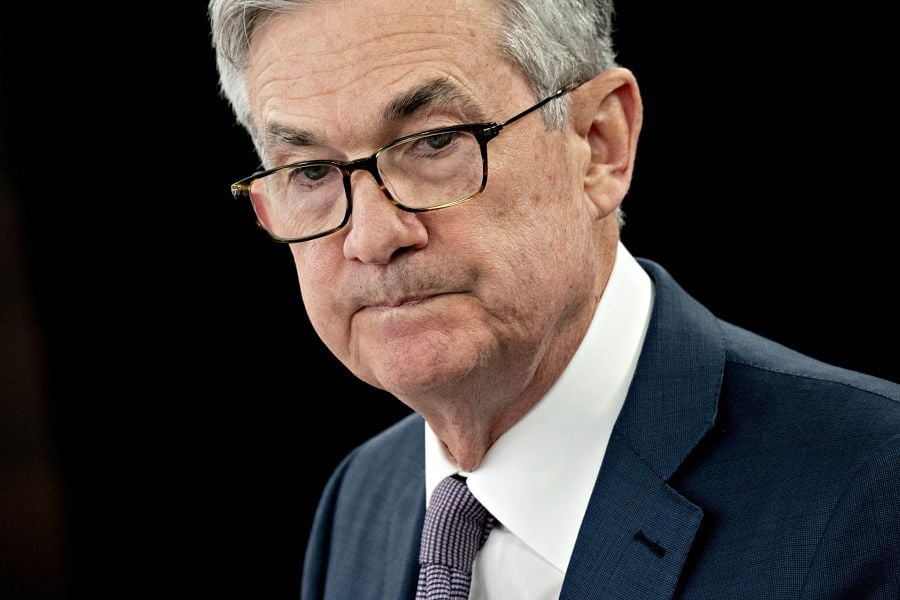

Federal Reserve Chairman Jerome Powell pushed back against the prospect the central bank would deploy negative interest rates in the U.S., though he didn’t fully rule out the option as a potential tool in the future.
“The evidence on negative rates is mixed,” Powell said Wednesday in response to a question after giving a speech via video. He noted that Fed officials had debated whether to follow other central banks in that direction and opted to use other tools, and said “for now it’s not something we’re considering.”
The S&P 500 fell at the open and traders pushed bets on a negative Fed benchmark rate later into next year as investors absorbed Powell’s speech, which highlighted the possibility of lasting economic harm due to the coronavirus pandemic.
The U.S. economy faces unprecedented risks if fiscal and monetary policy makers don’t rise to the challenge, Powell said.
“The recovery may take some time to gather momentum, and the passage of time can turn liquidity problems into solvency problems,” Powell said Wednesday in remarks to a virtual event hosted by the Peterson Institute for International Economics in Washington. “Additional fiscal support could be costly, but worth it if it helps avoid long-term economic damage and leaves us with a stronger recovery.”
Powell and his colleagues on the policy-setting Federal Open Market Committee have taken dramatic measures to shelter the U.S. economy during the coronavirus pandemic. They have cut their benchmark interest rate to nearly zero, engaged in open-ended bond buying and begun rolling out emergency lending programs as U.S. unemployment has soared to levels not seen since the 1930s Great Depression.
Some investors have speculated the Fed might follow other central banks in taking interest rates into negative territory to spur spending, with interest rate futures indicating a small change it might happen. Powell acknowledged the discussion but said it was not being considered, though he stopped short of ruling the tool out as an option in the future.
”The committee’s view on negative rates really has not changed. This is not something that we’re looking at,” he said. “I know that there are fans of the policy, but for now, it’s not something that we’re considering. We think we have a good toolkit, and that’s the one we’ll be using.”
Worrying scenario
In his speech, the Fed outlined the worrying scenario posed by mass bankruptcies and unemployment while asserting that policymakers may have to do more to prevent these from coming to pass. He said the Fed would publish a survey Thursday showing almost 40% of Americans in households making less than $40,000 a year had lost a job in March.
“Long stretches of unemployment can damage or end workers’ careers as their skills lose value and professional networks dry up, and leave families in greater debt,” Powell said. “The loss of thousands of small and medium-sized businesses across the country would destroy the life’s work and family legacy of many business and community leaders and limit the strength of the recovery when it comes.”
Congressional lawmakers and President Donald Trump’s administration have passed almost $3 trillion in economic relief measures, including $454 billion to serve as a backstop for the central bank’s emergency programs. Democrats and Republicans are currently talking about another round of aid, including measures to shore up state and local governments whose tax revenues have been decimated by stay-at-home orders that have shuttered entire sectors of the economy.
‘Significant’ risks
“While the economic response has been both timely and appropriately large, it may not be the final chapter, given that the path ahead is both highly uncertain and subject to significant downside risks,” Powell said.
In an unprecedented step, the Fed this week also began buying exchange-traded funds invested in corporate debt to support liquidity in the market where large companies borrow.
Powell added that the central bank would “continue to use our tools to their fullest until the crisis has passed and the economic recovery is well under way,” but cautioned that it could only make loans and not spend money.
“When this crisis is behind us, we will put these emergency tools away,” he said.

Integrated Partners is adding a mother-son tandem to its network in Missouri as Kestra onboards a father-son advisor duo from UBS.

Futures indicate stocks will build on Tuesday's rally.

Cost of living still tops concerns about negative impacts on personal finances

Financial advisors remain vital allies even as DIY investing grows

A trade deal would mean significant cut in tariffs but 'it wont be zero'.
RIAs face rising regulatory pressure in 2025. Forward-looking firms are responding with embedded technology, not more paperwork.
As inheritances are set to reshape client portfolios and next-gen heirs demand digital-first experiences, firms are retooling their wealth tech stacks and succession models in real time.
